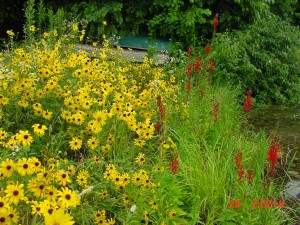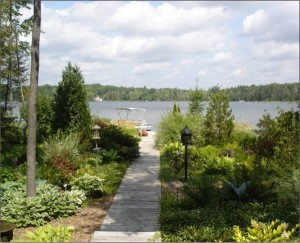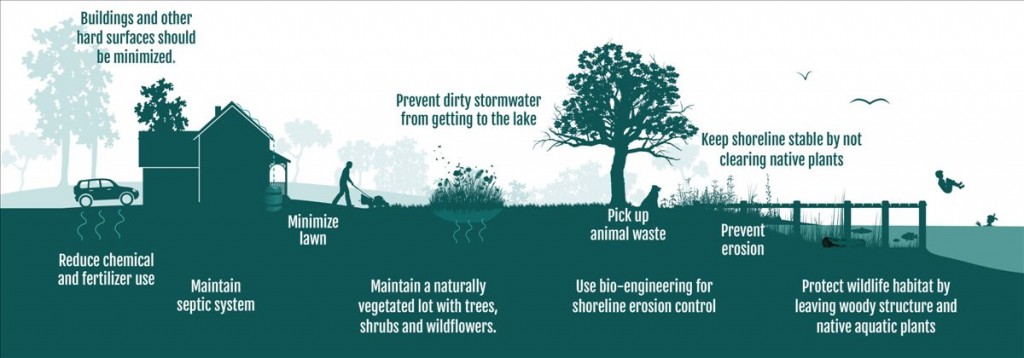Life on the edge: Shoreland Stewards program provides conservation tools for lakefront property owners

With Memorial Day fast approaching, many Michiganders are preparing to re-open cottages on the state’s more than 11,000 inland lakes. If you’re lucky enough to have a summer place on the water or live lakeside year-round, the way you landscape and manage your property can have a big impact on water quality and lake-dwelling wildlife.
Enter the Michigan Shoreland Stewards program. Launched last year by the Michigan Natural Shoreline Partnership, the program recognizes property owners who are using healthy property management practices to protect their inland lake and recommends steps they can take to further improve shoreline health.
“Our goal is to not only educate people about the issues our inland lakes are facing, but to give them some easy ways to work toward protecting their lake,” says Eli Baker, education and outreach specialist with Tip of the Mitt Watershed Council, a Petoskey-based member group of MEC and of the shoreline partnership.
When it comes to the life of an inland lake, the real action is near the shoreline. Bass, bluegills and other popular game fish species spawn in the shallows, as do frogs, toads and salamanders. Mayflies burrow into the nearshore sediment. Ducks, loons and other water birds make their nests on the banks. Minks and raccoons stalk the shoreline for a meal.
Along with providing important habitat for fish and wildlife, natural shorelines also filter out excess nutrients, keep the water cool by providing shade and stabilize banks by minimizing erosion from waves and ice.
Unfortunately, the shorelines of Michigan’s inland lakes are threatened by development. Property owners are replacing more and more of this important habitat with seawalls, turfgrass lawns and impervious surfaces like driveways and buildings.
Ten years ago the U.S. Environmental Protection Agency conducted its first-ever National Lakes Assessment. Working with the state Department of Environmental Quality, the EPA found that 40 percent of Michigan lakes had poor shoreline habitat and loss of that habitat was the biggest stressor on the health of our inland lakes.
“With the removal of those natural shorelines, the capacity of wildlife to populate those areas is reduced, and the fish populations in the lakes are having a harder time surviving there,” Baker says.
The Shoreland Stewards program seeks to reverse that trend. It involves a free online questionnaire about how participants manage their lakefront property. Based on the responses, property owners can earn a gold, silver or bronze certification, or be scored at a starter level. The online tool then provides customized information about steps landowners can take to improve their shoreline habitat. Participants receive a free certificate or can pay for a sign to display on their property.
So far more than 400 people representing 30,000 feet of shoreline have taken the Shoreland Stewards survey. Baker is reaching out to lake associations as a way to promote lake-wide adoption of environmentally friendly management practices. So far 19 associations have participated.
The program recommends best practices like keeping the shoreline stable by not removing native plants from the water’s edge or from the lake; maintaining the property’s septic system to prevent pollution; cleaning up pet waste; and choosing trees, shrubs and wildflowers instead of a turf lawn.
At this point the program doesn’t include a way to determine if survey takers followed through with the property-management changes that the online tool recommended to them, but Baker says the partnership is working on it.
For now, he encourages lakefront property owners to complete the survey and take action to improve their shoreline for wildlife and water quality.
“Many people don’t realize how intimately connected lakes are to the land that surrounds them,” Baker says. “We hope that the Michigan Shoreland Stewards Survey will help property owners to better understand this connection and live in harmony with their lake. If you are interested in learning more about how to prevent erosion, protect your lakes waters, or even keep pesky geese away, I encourage you to take the survey today.”
###
Photos courtesy Eli Baker.
Browse these next
- Non Gamstop Casino
- Casino Online Migliori Italia
- Non Gamstop Casinos
- Casinos Not On Gamstop
- Casino Online Non Aams
- Non Gamstop Casino UK
- Best Non Gamstop Casinos
- Best Non Gamstop Casinos
- Online Betting Sites Not On Gamstop
- Non Gamstop Casino UK
- UK Casinos Not On Gamstop
- UK Casino Not On Gamstop
- Gambling Sites Not On Gamstop
- Casinos Not On Gamstop
- Non Gamstop Casino
- Casino En Ligne Meilleur Site
- Casino En Ligne Meilleur Site
- Casino En Ligne France
- Non Gamstop Casino Sites UK
- Top UK Casino Sites
- Best Online Casinos Uk
- Lista Casino Online Non Aams
- Casinos Not On Gamstop
- Casino Online Non Aams
- Casino Non Aams
- Meilleur Casino En Ligne Belgique
- Siti Scommesse Bitcoin




Comments are closed.